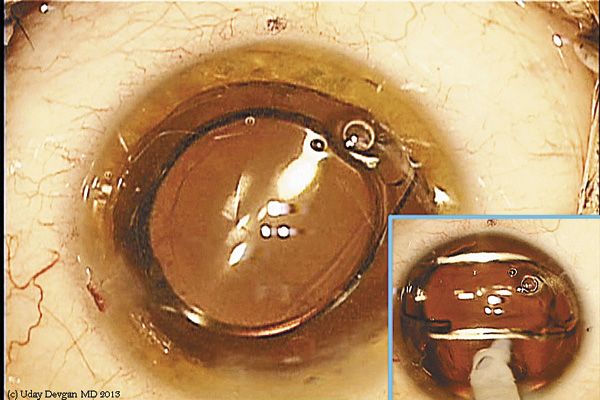Article
In control: Unfolding a monofocal lens
A single-piece hydrophobic acrylic IOL has many features that make it a good choice for a monofocal implant in routine and challenging cataract surgery cases.
TAKE HOME:
A single-piece hydrophobic acrylic IOL has many features that make it a good choice for a monofocal implant in routine and challenging cataract surgery cases.

The controlled unfolding of the single-piece hydrophobic acrylic IOL (enVista, Bausch + Lomb) allows times for the surgeon to get behind the IOL optic to remove the viscoelastic completely (insert), before the lens unfolds into its final position (large photo). (Images courtesy of Uday Devgan, MD)
Los Angeles-In cataract surgery cases where a monofocal IOL will be implanted after crystalline lens removal, multiple reasons exist where a surgeon might consider a single-piece hydrophobic acrylic IOL (enVista, Bausch + Lomb) , notes one surgeon.
For instance, the lens combines the advantages of having an acrylic material with that of single-piece construction, explained Uday Devgan, MD, private practice and chief of ophthalmology, Olive View UCLA Medical Center, Los Angeles.
The IOL became available to U.S. surgeons in June 2012, and Dr. Devgan began using it after the product’s launch. Based on his positive experience with the lens over the past year, he said it has become a great option for most patients who are not seeking a toric or presbyopia-correcting IOL.
“Considering both the intraoperative performance of the . . . IOL and the postoperative outcomes I’ve achieved, it seems that Bausch + Lomb has a winner with its first foray into the hydrophobic acrylic lens market,” Dr. Devgan said.
The novel hydrophobic acrylic polymer, which was licensed by Bausch + Lomb from Santen (Japan) and has a 5-year clinical track record, is notable for its robustness and being glistening-free, said Dr. Devgan, in discussing the lens.
“The hydrophobic acrylic material is very resistant to surface damage that can occur during handling, and it is hydrated to an equilibrium water content of 4% that is maintained on the shelf through packaging in saline,” Dr. Devgan said. “The hydration intends to prevent the development of glistenings, and appears to be working.
“In my experience, the . . . IOL seems nearly invisible in the eye with no evidence of glistenings or other fine opacities,” he added.
Centration and stability

Dr. DevganThe hydrophobic acrylic IOL unfolds in a slow and controlled manner that enables complete removal of viscoelastic from behind the lens. It centers well and maintains good positional stability post-implantation due to its material and haptic design.
“Even in some more challenging cases where there is the potential for increased capsular fibrosis, the . . . IOL tends to keep its form because of its rigid material and [does] not shift around,” Dr. Devgan said.
However, he noted that good visual quality would be maintained if there is some lens decentration because the optic is spherical aberration-neutral.
“Unlike aspheric lenses with negative spherical aberration where visual performance is highly sensitive to decentration, [this] IOL is optically immune to mild decentration because it has zero spherical aberration,” he said. “For that reason, it is a great choice in cases where there are any anatomical issues leading to IOL centration concerns.
“This zero spherical aberration IOL also does not confound any existing aberrations in the eye, which makes it a great choice in eyes with prior keratorefractive surgery, like RK or corneal irregularity,” Dr. Devgan said.
The intraocular stability of the single-piece hydrophobic acrylic IOL also suggests it is a good platform for toric IOL technology, and the presence of two holes where the haptic joins the optic raises the interesting possibility of using those openings to enable suture fixation in challenging cases, said Dr. Devgan, noting that he has not yet tried the latter maneuver.
Uday Devgan, MD
Dr. Devgan is currently a consultant to Bausch + Lomb and to other companies that market IOLs (Aaren Scientific, Alcon Laboratories, and Hoya). He previously was also a consultant to Abbott Medical Optics and STAAR Surgical.
Subscribe to Ophthalmology Times to receive the latest clinical news and updates for ophthalmologists.
Newsletter
Don’t miss out—get Ophthalmology Times updates on the latest clinical advancements and expert interviews, straight to your inbox.





